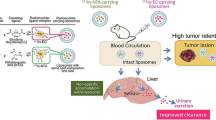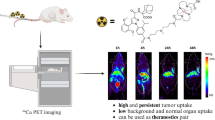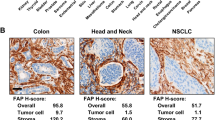Abstract
Purpose
Site-specific approaches to bioconjugation produce well-defined and homogeneous immunoconjugates with potential for superior in vivo behavior compared to analogs synthesized using traditional, stochastic methods. The possibility of incorporating photoaffinity chemistry into a site-specific bioconjugation strategy is particularly enticing, as it could simplify and accelerate the preparation of homogeneous immunoconjugates for the clinic. In this investigation, we report the synthesis, in vitro characterization, and in vivo evaluation of a site-specifically modified, 89Zr-labeled radioimmunoconjugate created via the reaction between an mAb and an Fc-binding protein bearing a photoactivatable 4-benzoylphenylalanine residue.
Procedures
A variant of the Fc-binding Z domain of protein A containing a photoactivatable, 4-benzoylphenylalanine residue — Z(35BPA) — was modified with desferrioxamine (DFO), combined with the A33 antigen-targeting mAb huA33, and irradiated with UV light. The resulting immunoconjugate — DFOZ(35BPA)-huA33 — was purified and characterized via SDS-PAGE, MALDI-ToF mass spectrometry, surface plasmon resonance, and flow cytometry. The radiolabeling of DFOZ(35BPA)-huA33 was optimized to produce [89Zr]Zr-DFOZ(35BPA)-huA33, and the immunoreactivity of the radioimmunoconjugate was determined with SW1222 human colorectal cancer cells. Finally, the in vivo performance of [89Zr]Zr-DFOZ(35BPA)-huA33 in mice bearing subcutaneous SW1222 xenografts was interrogated via PET imaging and biodistribution experiments and compared to that of a stochastically labeled control radioimmunoconjugate, [89Zr]Zr-DFO-huA33.
Results
HuA33 was site-specifically modified with Z(35BPA)-DFO, producing an immunoconjugate with on average 1 DFO/mAb, high in vitro stability, and high affinity for its target. [89Zr]Zr-DFOZ(35BPA)-huA33 was synthesized in 95% radiochemical yield and exhibited a specific activity of 2 mCi/mg and an immunoreactive fraction of ~ 0.85. PET imaging and biodistribution experiments revealed that high concentrations of the radioimmunoconjugate accumulated in tumor tissue (i.e., ~ 40%ID/g at 120 h p.i.) but also that the Z(35BPA)-bearing immunoPET probe produced higher uptake in the liver, spleen, and kidneys than its stochastically modified cousin, [89Zr]Zr-DFO-huA33.
Conclusions
Photoaffinity chemistry and an Fc-binding variant of the Z domain were successfully leveraged to create a novel site-specific strategy for the synthesis of radioimmunoconjugates. The probe synthesized using this method — DFOZ(35BPA)-huA33 — was well-defined and homogeneous, and the resulting radioimmunoconjugate ([89Zr]Zr-DFOZ(35BPA)-huA33) boasted high specific activity, stability, and immunoreactivity. While the site-specifically modified radioimmunoconjugate produced high activity concentrations in tumor tissue, it also yielded higher uptake in healthy organs than a stochastically modified analog, suggesting that optimization of this system is necessary prior to clinical translation.




Similar content being viewed by others
Data availability
Data are available upon request.
Abbreviations
- DFO:
-
Desferrioxamine
- BPA:
-
4-Benzoylphenylalanine
- Z(35BPA):
-
Z domain of protein A with 4-benzoylphenylalanine
- ADC:
-
Antibody-drug conjugate
- PET:
-
Positron emission tomography
- DOL:
-
Degree of labeling
- IgG:
-
Immunoglobulin
- mAb:
-
Monoclonal antibody
- SDS-PAGE:
-
Sodium dodecyl sulfate polyacrylamide gel electrophoresis
- IMAC:
-
Immobilized metal affinity chromatography
- MALDI-ToF:
-
Matrix-assisted laser desorption / time-of-flight mass spectrometry
- IACUC:
-
Institutional Animal Care and Use Committee
- %ID/g:
-
Percent of injected dose per gram
- PBS:
-
Phosphate-buffered saline
- DMSO:
-
Dimethyl sulfoxide
- RPM:
-
Revolutions per minute
- RCF:
-
Relative centrifugal force
- EDTA:
-
Ethylenediaminetetreaacetic acid
- iTLC:
-
Instant thin layer chromatography
References
Rudnick SI, Adams GP (2009) Affinity and avidity in antibody-based tumor targeting. Cancer Biother Radiopharm 24:155–161
Vivier D, Sharma SK, Zeglis BM (2018) Understanding the in vivo fate of radioimmunoconjugates for nuclear imaging. J Labelled Comp Radiopharm 61:672–692
Wu AM (2009) Antibodies and Antimatter: The resurgence of immuno-PET. J Nucl Med 50:2–5
Sharma SK, Glaser JM, Edwards KJ et al (2021) A systematic evaluation of antibody modification and (89)Zr-radiolabeling for optimized immuno-PET. Bioconjug Chem 32:1177–1191
Tavaré R, Wu WH, Zettlitz KA et al (2014) Enhanced immunoPET of ALCAM-positive colorectal carcinoma using site-specific (64)Cu-DOTA conjugation. Protein Eng Des Sel 27:317–324
Agarwal P, Bertozzi CR (2015) Site-specific antibody-drug conjugates: the nexus of bioorthogonal chemistry, protein engineering, and drug development. Bioconjug Chem 26:176–192
Jeger S, Zimmermann K, Blanc A et al (2010) Site-specific and stoichiometric modification of antibodies by bacterial transglutaminase. Angew Chem Int Ed Engl 49:9995–9997
Ahn SH, Vaughn BA, Solis WA, Lupher ML Jr, Hallam TJ, Boros E (2020) Site-specific (89)Zr- and (111)In-radiolabeling and in vivo evaluation of glycan-free antibodies by azide-alkyne cycloaddition with a non-natural amino acid. Bioconjug Chem 31:1177–1187
Adumeau P, Sharma SK, Brent C, Zeglis BM (2016) Site-specifically labeled immunoconjugates for molecular imaging – Part 1: Cysteine residues and glycans. Mol Imaging Biol 18:1–17
Adumeau P, Sharma SK, Brent C, Zeglis BM (2016) Site-specifically labeled immunoconjugates for molecular imaging – Part 2: Peptide tags and unnatural amino Acids. Mol Imaging Biol 18:153–165
Jendeberg L, Tashiro M, Tejero R et al (1996) The mechanism of binding staphylococcal protein A to immunoglobin G does not involve helix unwinding. Biochemistry 35:22–31
Konrad A, Karlström AE, Hober S (2011) Covalent immunoglobulin labeling through a photoactivable synthetic Z domain. Bioconjug Chem 22:2395–2403
Ultsch M, Braisted A et al (2017) 3-2-1: Structural insights from stepwise shrinkage of a three-helix Fc-binding domain to a single helix. Protein Eng Des Sel 30:619–625
Perols A, Karlström AE (2014) Site-specific photoconjugation of antibodies using chemically synthesized IgG-binding domains. Bioconjug Chem 25:481–488
Kanje S, Hober S (2015) In vivo biotinylation and incorporation of a photo-inducible unnatural amino acid to an antibody-binding domain improve site-specific labeling of antibodies. Biotechnol J 10:564–574
Stiller C, Aghelpasand H, Frick T, Westerlund K, Ahmadian A, Karlström AE (2019) Fast and efficient Fc-specific photoaffinity labeling to produce antibody-DNA conjugates. Bioconjug Chem 30:2790–2798
von Witting E, Hober S, Kanje S (2021) Affinity-based methods for site-specific conjugation of antibodies. Bioconjug Chem 32:1515–1524
Westerlund K, Vorobyeva A, Mitran B et al (2019) Site-specific conjugation of recognition tags to trastuzumab for peptide nucleic acid-mediated radionuclide HER2 pretargeting. Biomaterials 203:73–85
King DJ, Antoniw P, Owens RJ et al (1995) Preparation and preclinical evaluation of humanised A33 immunoconjugates for radioimmunotherapy. Br J Cancer 72:1364–1372
Lee FT, Hall C, Rigopoulos A et al (2001) Immuno-PET of human colon xenograft- bearing BALB/c nude mice using (124)I-CDR-grafted humanized A33 monoclonal antibody. J Nucl Med 42:764–769
Zeglis BM, Lewis JS (2011) A practical guide to the construction of radiometallated bioconjugates for positron emission tomography. Dalton Trans 40:6168–6195
Carrasquillo JA, Pandit-Taskar N, O’Donoghue JA et al (2011) (124)I-huA33 antibody PET of colorectal cancer. J Nucl Med 52:1173–1180
Zeglis BM, Lewis JS (2015) The bioconjugation and radiosynthesis of (89)Zr-DFO-labeled antibodies. JoVE (96):e52521
Cook BE, Adumeau P, Membreno R et al (2016) Pretargeted PET imaging using a site-specifically labeled immunoconjugate. Bioconjug Chem 27:1789–1795
Adumeau P, Davydova M, Zeglis BM (2018) Thiol-reactive bifunctional chelators for the creation of site-selectively modified radioimmunoconjugates with improved stability. Bioconjug Chem 29:1364–1372
Heath JK, White SJ, Johnstone CN et al (1997) The human A33 antigen is a transmembrane glycoprotein and a novel member of the immunoglobulin superfamily. Proc Natl Acad Sci USA 94:469–474
Höglund J, Orlova A, Sundin A, Lundqvist H, Tolmachev V (2006) Cellular processing in the SW1222 cell line of mAb A33 directly and indirectly radiohalogenated. Oncol Rep 16:159–163
Vosjan MJ, Perk LR, Visser GW et al (2010) Conjugation and radiolabeling of monoclonal antibodies with zirconium-89 for PET imaging using the bifunctional chelate p-isothiocyanatobenzyl-desferrioxamine. Nat Protoc 5:739–743
Myrhammar A, Vorobyeva A et al (2020) Evaluation of an antibody-PNA conjugate as a clearing agent for antibody-based PNA-mediated radionuclide pretargeting. Sci Rep 10:20777
Gogesch P, Dudek S, van Zandbergen G et al (2021) The role of Fc receptors on the effectiveness of therapeutic monoclonal antibodies. Int J Mol Sci 22:8947
Pyzik M, Rath T, Lencer WI et al (2015) FcRn: the architect behind the immune and nonimmune functions of IgG and albumin. J Immunol 194:4595–4603
Sharma SK, Suzuki M, Xu H et al (2022) Influence of Fc modifications and IgG subclass on biodistribution of humanized antibodies targeting L1CAM. J Nucl Med 63:629–636
Braisted AC, Wells JA (1996) Minimizing a binding domain from protein A. Proc Natl Acad Sci USA 93:5688–5692
Choe W, Durgannavar TA, Chung SJ (2016) Fc-binding ligands of immunoglobulin G: an overview of high affinity proteins and peptides. Materials 9:994
Sockolosky JT, Kivimäe S, Szoka FC (2014) Fusion of a short peptide that binds immunoglobulin G to a recombinant protein substantially increases its plasma half-life in mice. PLoS ONE 9:e102566
Funding
This work was supported by funding from the National Institutes of Health to BMZ (R01CA240963, U01CA221046, R01CA204167, R21EB030275 and R01CA244327) and SD (F31CA275334) as well as funding from the Swedish Research Council (2020-04478 and 2018-06228) and the Swedish Cancer Society (22 2203 Pj 01 H) to AEK. The authors also thank the MSKCC Small Animal Imaging Core Facility and the MSKCC Radiochemistry and Molecular Imaging Probe Core.
Author information
Authors and Affiliations
Corresponding authors
Ethics declarations
Conflict of Interest
The authors declare no competing interests.
Additional information
Publisher's Note
Springer Nature remains neutral with regard to jurisdictional claims in published maps and institutional affiliations.
Supplementary Information
Below is the link to the electronic supplementary material.
Rights and permissions
Springer Nature or its licensor (e.g. a society or other partner) holds exclusive rights to this article under a publishing agreement with the author(s) or other rightsholder(s); author self-archiving of the accepted manuscript version of this article is solely governed by the terms of such publishing agreement and applicable law.
About this article
Cite this article
Delaney, S., Nagy, Á., Karlström, A.E. et al. Site-Specific Photoaffinity Bioconjugation for the Creation of 89Zr-Labeled Radioimmunoconjugates. Mol Imaging Biol 25, 1104–1114 (2023). https://doi.org/10.1007/s11307-023-01818-5
Received:
Revised:
Accepted:
Published:
Issue Date:
DOI: https://doi.org/10.1007/s11307-023-01818-5




